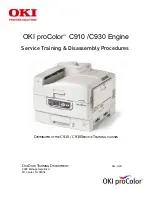
will repel the ink that is not absorbed, especially if the pad is incorrectly placed too close
to required openings. This rebounding ink will be re-deposited into the surrounding area
and cause soiling of printer components as well as a greater concentration of ink particles
in the air.
For more details on the characteristics of the two ink types and comparisons of their fea-
tures, see Application Bulletin 28 - "Selecting Appropriate Océ Ink for Your Applications:
Océ IJC255 or Océ IJC256" on the customer support web site at http://dgs.oce.com/.
These inks have very little odor, but for optimal safety some ventilation is needed. The
printer should operate in an area where a good standard of general ventilation is available
at 5 to 10 air changes per hour. Mechanical ventilation must be added where the air
changes are under 5 per hour. Refer to the Site Preparation Guide for minimum
space/working room volume for the printer.
Note:
Read the section on ink safety called "Safety Guidelines for Ink Material" before you
handle the ink.
The printer is optimized for the specific UV-curable ink supplied by Océ Display
Graphics Systems. The ink is supplied to the printer in 2 liter collapsible bags that are
loaded into the printer by means of quick-change connectors that are bonded into the
top corner. To install on the printer, the bags are inverted and the quick connect couplers
are pushed into their corresponding female coupling. This opens up the flow path for
the ink. The bags contain tags that identifies them to the printer when they are loaded.
This allows the printer to ensure that the correct ink is loaded.
This method of ink delivery has several benefits over bottles or cartridges:
The self-collapsing bags make it easy to see how much ink remains in each bag.
• Virtually all the ink is successfully extracted from the bag by the printer, reducing the
otherwise costly waste of usable ink.
• Ink changes are performed without mess or spills, keeping the environment around
the printer clean.
• Ink changes can be performed during printing - this prevents wasted prints and lost
time.
Only qualified inks can be used. If a bag of ink with an invalid serial number, expired
use-by date, incorrect color placement in the ink bay, or if an expired tag is connected to
the printer, then the operator is alerted and an error message is displayed.
The ink delivery system provides the printheads with ink at the appropriate temperature
and pressure. Each printhead has a corresponding ink reservoir on the carriage. Pumps
supply ink to the reservoirs on demand. Sensors in the reservoirs control the level of ink
and initiate demand when required. Ink temperature control is achieved by pumping a
Chapter 10 - Ink System Management
201
Arizona Printer Inks
Summary of Contents for Arizona 400 Series GT
Page 1: ...Oc Arizona 400 Series GT Oc Arizona 440 460 480 GT XT Revision A Oc User Manual...
Page 6: ...6 Contents...
Page 7: ...Chapter 1 Introduction...
Page 14: ...Chapter 1 Introduction 14 Product Compliance...
Page 15: ...Chapter 2 Product Overview...
Page 18: ...Chapter 2 Product Overview 18 Printer Specifications...
Page 19: ...Chapter 3 Safety Information...
Page 41: ...Chapter 4 How to Navigate the User Interface...
Page 71: ...Chapter 5 How to Operate Your Oc Arizona Printer...
Page 97: ...Chapter 6 How to Operate the Oc Arizona 400 Series XT...
Page 104: ...Chapter 6 How to Operate the Oc Arizona 400 Series XT 104 How to Print With Dual Origins...
Page 105: ...Chapter 7 How to Operate the Roll Media Option...
Page 136: ...Chapter 7 How to Operate the Roll Media Option 136 How to Use Media Edge Protectors...
Page 137: ...Chapter 8 How to Use the Static Suppression Upgrade Kit...
Page 141: ...Chapter 9 How to Work With White Ink and Varnish...
Page 198: ...Chapter 9 How to Work With White Ink and Varnish 198 How to Create and Use Quick Sets...
Page 199: ...Chapter 10 Ink System Management...
Page 206: ...Chapter 10 Ink System Management 206 How to Change Ink Bags...
Page 207: ...Chapter 11 Error Handling and Trou bleshooting...
Page 211: ...Chapter 12 Printer Maintenance...
Page 265: ...Appendix A Application Information...
















































